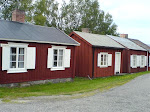Found something interesting in the pharmacy’s paper "Sommarspecial - Apoteket nummer 2, 2007 - tidning för apotekets kunder" *, which I took (it doesn't cost anything! :-)) when I was to the pharmacy to buy body lotion and deodorant the other day – an article about vacation that I thought was good!!! Here a fast and spontaneous translation.
Do we use the hammock during vacation? Do we get the rehabilitation we need? The rehabilitation which is so important for the rest of the year to manage our jobs - and lives. Well, that depends on how we handle our vacations it stood in the article (a tip for Swedish people is to go to a pharmacy and take a paper and read, unfortunately the article wasn't on the web).
That vacation means that we are free from our regular (ordinary?) works, we all of course agree about, but do we stop working? What do we do those weeks (do we have to "do" anything? And if so what?)?
Are we lying at the beach, do we go see the family or do we do joinery on the house? Do we get stressed over everything we should need to do but will not be able to do of different reasons; hindered by something?
Does the new technique mean that we have problems with letting work go?
If one belong to the last group you need to watch yourself. Because vacation is very important for getting a real rehabilitation and relaxation.
Our bodies have a remarkable ability to adapt to long work days and stress. But we need to rest now and then – and then we need a jolly good rest!? :-)
For many evenings and weekends fill this function, but we also need a longer break sometimes, to be able to relax really. And then only a couple of days aren’t enough the professor in psycho social medicine Torbjörn Åkerstedt at the Karolinska institute in Stockholm says.
To (re)build the immune protection we need at least three weeks vacation. It namely takes some week to go down in stress-levels and the last week before we start working the activity in the system goes up again. So we need a certain amount of relaxation to really recover.
There is amazingly little research on the effects of vacation. But the studies that exist show that a vacation of longer duration makes us more alert, that we get a better sleep and that the stress-levels decreases. Which makes the immune protection better, for instance wounds heal better.
But to get these positive effects it’s important how we actually handle our free time!!
If vacation means that you yourself put higher demands on yourself or that others put high demands on you you don’t get the necessary "slowing down" of the system.
If this on top call forth feelings of discomfort – that you have to meet relatives you don’t feel really good with, you have to work on the house even if you don’t like joinery work or maybe practical work at all – then the vacation can become a torment.
Of course we have to adapt to/with the people we live together with Åkerstedt says, but it is important to make sure you get space for yourself and your own interests, for your own needs and for doing things you yourself like. The one that feels good with seeing relatives or renovating houses can of course do that, while the one that want to lie in the hammock can and maybe even shall do that.
Research indicate that it is important you do something else during your vacation compared to when you work. The one using his/her head much in work maybe need to do something with her/his body during vacation. And vice versa.
Besides it's good not doing anything at all, at least sometimes. Maybe that’s why so many like to lie on the beach, sit on a bridge and just stare at a float – or lie in the hammock. Through relaxation the body and brain gets a chance to recover from the stress it has been exposed for the rest of the year.
Which in turn means that the low budget-vacation on the beach or in the sofa at home can have well as good effects as things that cost a lot of money.
But if we don’t do anything for longer periods we can get under stimulated and that’s not good either!! J It’s a question of balance.
If you get hindered to do something you want to do that's not good either.
“Reach ability” can become a problem in today’s world: emails, portable computers, cell phones, for the ones that are deeply engaged in their works. This is often a problem in the exhaustion and burn out problematic Åkerstedt said.
But there are also works that you can engage in during vacation; most researchers, teachers, investigators, and artists (musicians for instance) work almost always. But during vacation they maybe let go of the “must-things”? And do the like-and-want-things? :-)
When we get stressed the heart beats faster and the blood-pressure goes up. When the stress decreases the body goes back to normal-level. But if you are stressed too often and for too a long time the body doesn’t manage to go back to a normal/resting level. Then there is risk for an over activated system, which on long term can result in obesity (the metabolic syndrome), weakened immune system, sleeping disturbances, heart problems and depression.
One way to cope with this is physical activity, which means release of endorfines (good for creativity!!!). But slackening/relaxation is also needed, because it gives the body and brain a chance to rehabilitate from the stress all the organs have been exposed to.
Don’t plan activities for all your free time, give room for just-be-time. If you have to compromise with the family make sure all gets space to do what they feel well doing – and even what you yourself feel well doing, i.e, don't forget yourself.
Physical activity is important, for the kick of the happy-hormones endorfines. And if you are training during the rest of the year you can try something else during your vacation.
If your hobby is your work – work enough much and let the family know you feel good doing this.
Don’t let the economy become a stress moment – plan your vacation from what your economy allow.
I hope I live after this... :-) With a work that is also my hobby.
English word of today “hammock” which means hängmatta in Swedish.
-//-
*Artikeln heter "Ta vara på din semester" och finns på sidorna 3-5.
-//-
Addition June 2: When I reread parts of this blog-post now the next day I came to think about those who doesn't have a work; who have no employment, are sick (home for exhaustion for instance) and the ones that are retired... For these an article of this kind can become an insult? Who goes at home day out and day in... And are under stimulated instead? The religion psychologist Owe Wikström writes about this...
And it's sick that one part of the population are working themselves almost exhausted while another part has no jobs... Some silent reflections...
And there is enough material wealth so there shouldn't exist any poor people in the world...
And we need other sorts of nutrition too; things that we (me and my colleagues for instance) produce: music, art, drama, books...
And lying in a hammock reading books is quite nice!! By the way... :-)




























